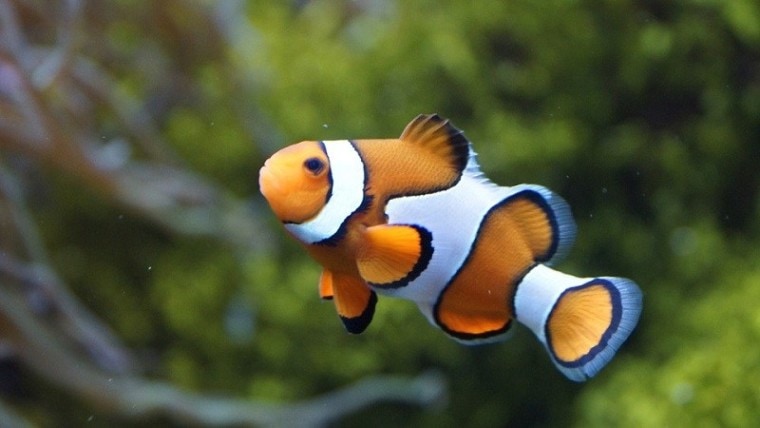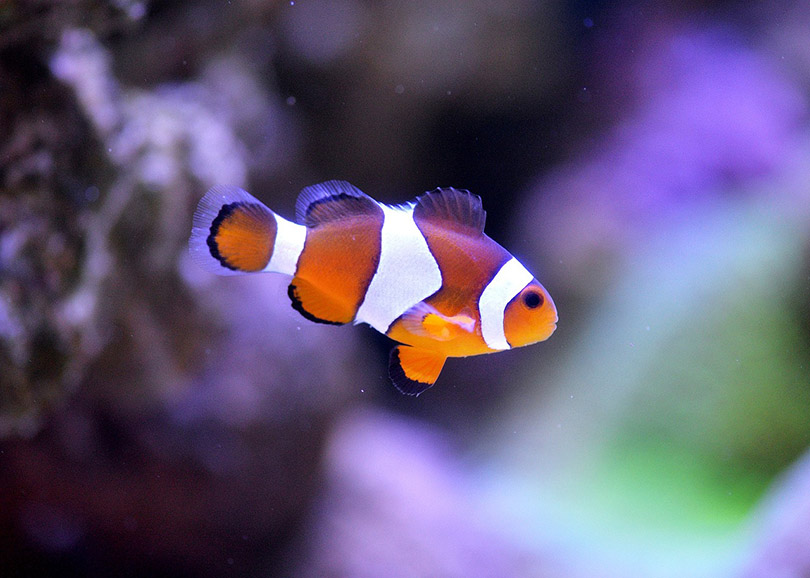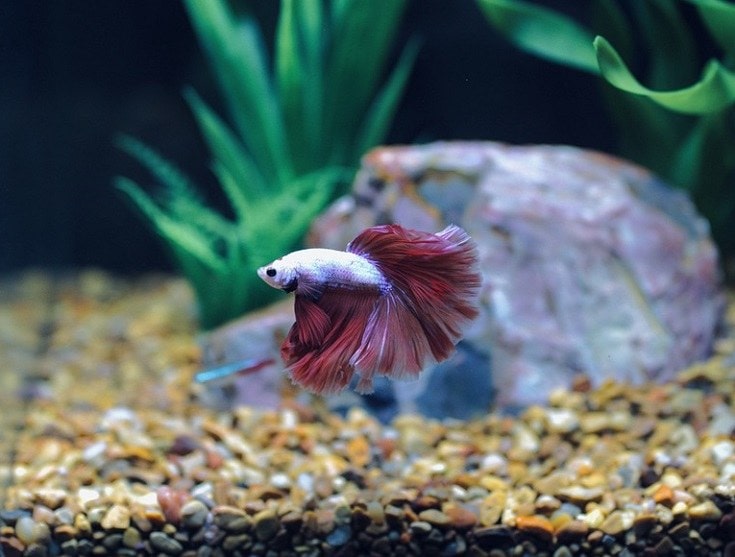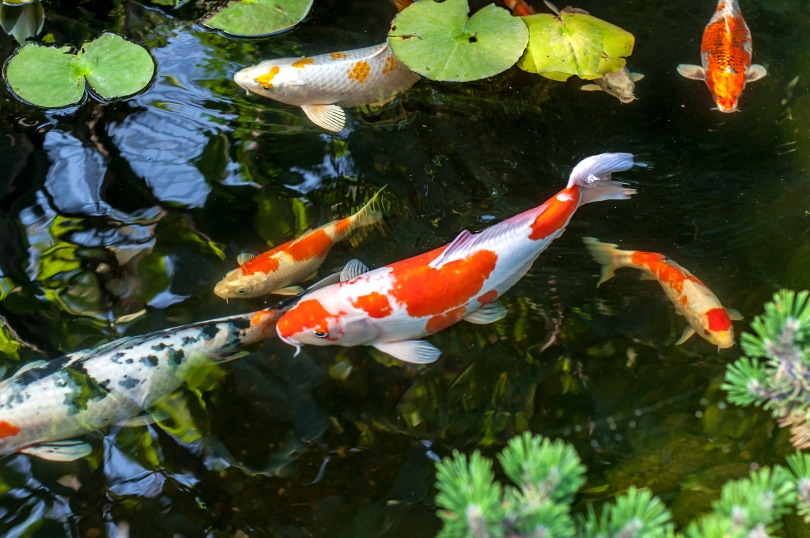
The world may not have been so familiar with clownfish until after Finding Nemo. This may be the image for some, but for fish lovers—this species is nothing new. They have been a saltwater aquarium favorite for decades, adding color and spice to so many setups.
If you’ve never had a clownfish before, you might want to know all of your options. There are many more colors than the traditional black, orange, and white ones you’ve come to love. We’ve rounded up 13 of the neatest clownfish around. Which one will catch your eye and wind up in your aquarium?
 The 13 Types of Clownfish for your Aquarium
The 13 Types of Clownfish for your Aquarium
1. Common or False Clownfish

The Common or False Clownfish is probably the ideal image that comes to your mind. Thanks to Disney, these fish surged in popularity. They are mostly comprised of vibrant orange bodies with black outlines on each fin. They have three vertical stripes on their face, middle, and tail portions.
These fish, unlike some other clownfish, are incredibly peaceful tankmates. They are omnivorous and reef compatible. Since they only reach 3 inches at maturity, they require only a 20-gallon tank.
It’s pretty easy to care for these little guys, so even a newbie can get into the swing of it.
2. Allard’s Clownfish
These dark, interesting-looking beauties are part of the Clarkii complex. Allards have a rounded facial structure with a blunt-ended tail, and their bodies are dark brown with neon orange highlights on the underbelly and fins. The two bold white stripes wrap evenly, sectioning the fish into thirds.
If you take proper care of these little fish, they can live up to 20 years. Mature adults reach roughly 5.5 inches. For one Allard, you’ll need at least a 30-gallon tank. These fish can live up to 20 years.
Like many other clownfish, Allards are very resilient and adaptable, making good choices for any fish lover.
3. Cinnamon Clownfish

Cinnamon Clownfish go by many names, like the Fire Clownfish and Red and Black Anemonefish. These fish are orangish-red with a dark overtone and a thick white vertical stripe behind each eye.
Cinnamon Clownfish are omnivorous and semi-aggressive with other fish. You’ll need at least a 30-gallon tank for one of these guys to explore, and each one reaches an average of 4 inches as adults. These fish can live up to 17 years.
These particular clownfish are very hardy, so they make ideal tank additions for beginners and experts alike.
4. Clarkii Clownfish

The Clarkii Clownfish, or Yellowtail Clownfish, is a beautiful, eye-catching specimen. These fish are bright yellow with dark brown blocks and white stripes. They have two humped dorsal fins on top with gently curved bodies.
The Clarkii is omnivorous and semi-aggressive with other tank mates. They require at least a 30-gallon tank to swim happily. Clarkii Clownfish are medium-sized, reaching 2 inches at maturity. These fish live an average of 14 years.
The Clarkii is extremely adaptable and hardy—thus, a popular aquarium choice.
5. Maroon Clownfish
The Maroon Clownfish is an incredibly interesting-looking little guy. They range from deep burgundy to bright red and have three uneven stripes. Rather than only sporting white stripes, these portions can even be yellow depending on the fish.
These fish generally live about 7 years on average. They reach around 6 inches when they are fully grown. But unlike some calmer clownfish, these guys are pretty aggressive with other fish, especially while spawning. They need tanks of at least 55 gallons to be happy.
While these fish are very easy to care for, the aggression part might be a little hard for beginners.
6. Oman Clownfish
The Oman Clownfish is a faint colored specimen that has a pale orangish-brown body and light orange fins. These fish have two bold white stripes around the forehead and down their middle.
The Oman is one of the largest clownfish species, averaging 6.1 inches. These fish are omnivores and are mildly aggressive with their tankmates. Always keep an eye on how they behave with your other fish. They need at least a 30-gallon tank to swim around in.
These fish are very adaptable, making them a good candidate for first-timers.
7. Pink Skunk Clownfish

The pretty Pink Skunk Clownfish is a coral-colored beauty. They have a very shallow dorsal fin that runs evenly down their spine. Unlike their cousins, they have a singular white stripe that runs vertically just behind the eye.
These pinkies don’t get very big, averaging about 3 inches in adulthood. They have omnivorous diets and can be slightly aggressive with other fish friends. If your Pink Skunk was born under human care, they are slightly easier to care for than their wild counterparts. They can live a whopping 21 years.
Caring for these clownfish isn’t as easy, so they’re best suited for experienced aquarists.
8. Saddleback Clownfish

The Saddleback Clownfish has fascinating markings and color. They can range from nearly black to burnt orange on their bodies. They have a bold white patch that goes over the dorsal fin (resembling a saddle), but it sometimes wraps to the underbelly. They also have a classic white strap just behind the head.
These fish can reach a maximum of 4 inches as adults. The Saddleback is omnivorous. They can be a bit fussy with tankmates, so look out for signs of aggression. These fish need at least a 30-gallon tank to live in. On average, they live for about 12 years.
Because they are a tad finickier than other clownfish, they do best with experienced owners.
9. Sebae Clownfish

The Sebae Clownfish has a very dark, nearly black body with a vibrant yellow underbelly. There are two vertical white stripes—one just behind the head, the other toward the backend. They also have a splash of yellow on their faces.
These clownfish are a bit on the bigger side, reaching about 6 inches as adults. They are omnivorous and semi-aggressive with other tankmates. You will need to provide at least a 30-gallon aquarium for these little swimmers. With proper care, they live an average of 12 years.
The Sebae is generally easy to care for, making them suitable for beginners.
10. Three-band Clownfish

The Three-band Clownfish lives up to its name, sporting three vertical white stripes evenly down its body. They have dark brown bodies with an orange face and fins. Their faces are perfectly flush with no notable points.
These hardy fish reach about 5 inches in adulthood. They are omnivorous and can be quite testy with tankmates sometimes. Three-bands need at least a 30-gallon tank to live in. If you play your cards right, they live up to 20 years.
Even though they can be a little aggressive with other fish, it’s nothing a newbie should worry about.
11. Tomato Clownfish
Tomato Clownfish probably get their name because they—well—look like tiny tomatoes. They are usually bright to dark red, with the lighter color being on the face and fins. They sport a singular white stripe just behind the eye.
As adults, Tomato Clownfish reach about 5 inches in length. They are omnivorous and can get a bit bullish with their cohabitants. You will need a 30-gallon tank or bigger for these fish. These guys can have a lifespan of anywhere between 2 to 15 years.
If you’re just starting out, you should be able to handle the care needs of a Tomato Clownfish.
12. True Percula Clownfish

The True Percula Clownfish looks very similar to the False Clownfish, but the white bands are much more whimsical and irregular. They can also have thick black patches on their bodies. Otherwise, they are the classic bold orange color with three white stripes.
As adults, True Perculas are the smallest of all clownfish, only reaching about 3 inches in all. They are omnivorous and sometimes pick fights with tankmates. These fish need at least a 30-gallon tank to live their best life—which can be up to 30 years! So, not only are they the tiniest, but they have the longest lifespan.
These clownfish are pretty easy to care for. So, if you’re a beginner, take a stab at it.
13. Red Sea Clownfish

The Red Sea Clownfish is one of the most unique of all its clownfish cousins. They have tiny bodies with big eyes. They also have more definition, making an almost diamond-like shape. They range between orange, tan, and yellow with a black patch on the back fin.
These clownfish reach up to 5.5 inches as adults. They are omnivorous and live pretty peacefully with other fish but might bully more passive mates. These guys need a 30-gallon tank at minimum for happy swimming. They can live quite a long time—up to 20 years with proper care.
If you’re a beginner, this fish is still compatible with your tank.
 Final Thoughts
Final Thoughts
As you can see, the clownfish has a lot more to offer than just orange, black, and white. They come in all sorts of interesting hues, temperaments, and sizes. If you don’t want that long of a commitment, you can choose a fish that lives just a few years, or you can choose one that lives over 20 years if you don’t want to have to part with them so soon.
With the appropriate conditions, any of these clownfish can make a charming addition to your aquarium. Choose wisely based on compatibility and enjoy the sight of your new tank member.
- Related Read: 11 Types of Fish in Finding Nemo (With Pictures)
Featured Image Credit: Taken, Pixabay

 The 13 Types of Clownfish for your Aquarium
The 13 Types of Clownfish for your Aquarium Final Thoughts
Final Thoughts





